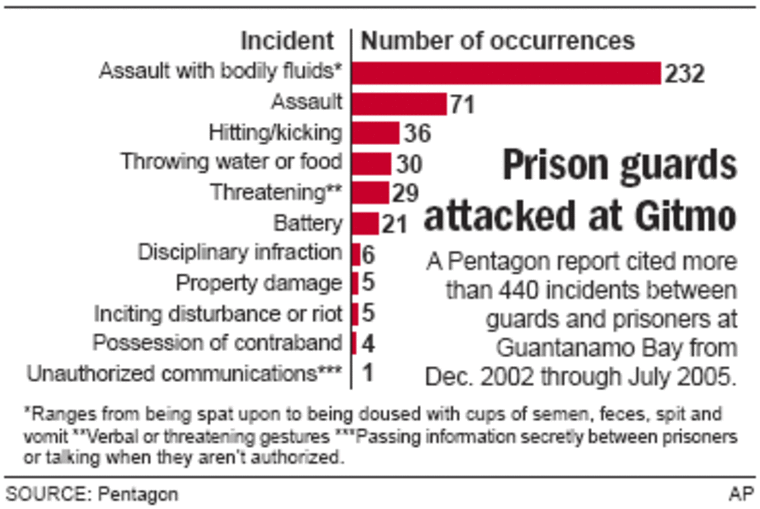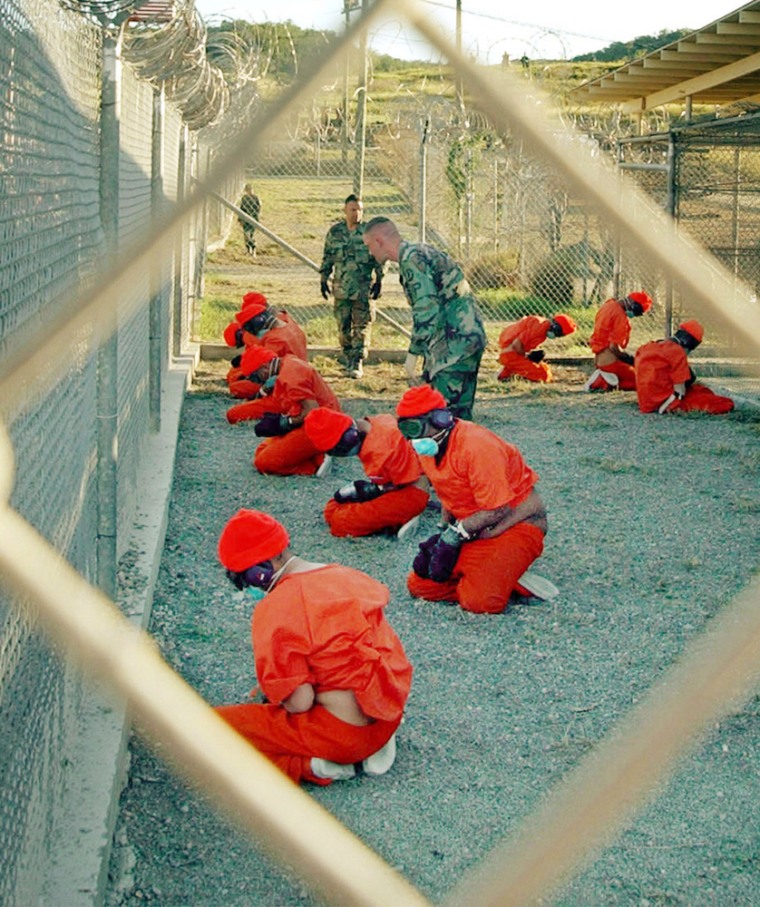The prisoners held at Guantanamo Bay during the war on terror have attacked their military guards hundreds of times, turning broken toilet parts, utensils, radios and even a bloody lizard tail into makeshift weapons, Pentagon reports say.
Incident reports reviewed by The Associated Press indicate Military Police guards are routinely head-butted, spat upon and doused by “cocktails” of feces, urine, vomit and sperm collected in meal cups by the prisoners.
They’ve been repeatedly grabbed, punched or assaulted by prisoners who reach through the small “bean holes” used to deliver food and blankets through cell doors, the reports say. Serious assaults requiring medical attention, however, are rare, the reports indicate.
The detainee “reached under the face mask of an IRF (Initial Reaction Force) team member’s helmet and scratched his face, attempting to gouge his eyes,” states a May 27, 2005, report on an effort to remove a recalcitrant prisoner from his cell.
“The IRF team member received scratches to his face and eye socket area,” the report said.
Controversial symbol
Since its creation in early 2002, the U.S. detention camp on Cuba’s coast has been a controversial symbol of the Bush administration’s war on terror, bringing allegations of prisoner mistreatment, debates over civil rights and a landmark legal battle to win rights for the detainees.
At one point, more than 600 foreign men captured in the war on terror were kept there. Many have been released to their home countries, reducing the current population to about 450. Ten detainees have been accused of war crimes, but no one has been tried.
The Supreme Court has ruled that the men are entitled to lawyers and access to the courts and that the administration’s original plan to give them justice through military tribunals was illegal.
Guards currently stationed at Guantanamo describe a tense atmosphere in which prisoners often orchestrate violence in hopes of unnerving their captors, especially with attacks using bodily fluids.
“I mean, seeing a human being act that way, it’s terrifying. ... You are constantly watching before you take your next step to see if something is about to happen,” Navy Senior Chief Petty Officer Mack D. Keen told AP in an interview from Guantanamo.
“You see little signs. They kind of show their hand every once in a while. They’ll take their Quran and they’ll cover it up,” he said. “When you see a group of detainees taking their Quran and putting it away, you know something is about to happen.”
‘Doesn’t make sense’
Moazamm Begg, 38, a prisoner for more than two years at Guantanamo before being released to Great Britain, said he was suspicious of the Pentagon’s description of incidents, especially allegations that Muslim men tore their Qurans or used sperm in attacks. The Pentagon continues to publicly question Begg’s claim of innocence.

“This just doesn’t make sense — especially since for Muslims this would be something that was disgusting, something that just wouldn’t be done,” he said.
He added that some detainees told him they had mixed toothpaste and spit in the cocktails to make it look like semen.
Begg, who has written a book and spoken frequently about his experience, said most incidents he witnessed were spontaneous reactions “when word spread” among prisoners that a guard had done something wrong.
“I rarely saw lone prisoners acting out on their own for no reason except if they had some sort of mental illness or if they were on medication,” he said.
Nonetheless, the incident reports released under the Freedom of Information Act and reviewed by AP provide a rare chronicle of events inside the prison from the guards’ perspective.
Entire wings of prisoners were reported to become riotous after complaints emerged that guards mishandled a Quran or mistreated prisoners. On two occasions, however, prisoners themselves were reported to have destroyed their Muslim holy books, the reports state.
“Detainee residing in cell (redacted) block tore his Quran into small pieces,” a guard reported in May 2003. A month later, a prisoner “did intentionally destroy his Quran and throw (it) out of his cell,” another report stated.
Hundreds of incidents
The reports detail more than 440 incidents between guards and prisoners from December 2002 through summer 2005 that resulted in recommendations of discipline, an average of about three per week. The names of guards and prisoners as well as the final discipline were blacked out by the Pentagon.
Often, guards went weeks without reporting problems; other times incidents were bunched together during times of frustration and tension.
For instance, nearly a quarter of the incidents occurred in July 2005, the month dozens of detainees started an extended hunger strike.
Tensions likewise flared during Christmas week 2004, with inmates frequently spitting on guards. On Christmas Eve, a prisoner who was angry that he couldn’t finish his meal was said to have used a plastic fork-spoon utensil — called a spork — to attack a guard collecting his tray.
“Detainee stabbed the MP guard ... in the hand with his spork from chow meal,” the report said, adding the prisoner later “made a slicing motion across his neck” and vowed to kill the guard.
With many nearing five years in U.S. captivity, the prisoners “have a Ph.D. in being a detainee” and “know our procedures and they try to turn them against us and try to make us question what we are doing,” said Army Lt. Col. Michael J. Nicolucci, the prison’s executive officer.
“They’ll take the smallest things, be it a piece of rust,” he said. “They told us they are going to take that piece of rust and they are going for the jugular, they are going for the eye. They know what our vulnerabilities are, anatomically speaking.”
Acts of violence
Meal plates, shower flip-flops, cleaning brushes and other items deemed harmless in civilian life also are commonly turned into weapons, the reports said. For instance:
- “Detainee in cell (redacted) grabbed the radio from an MP and then threw the radio at the MP. The detainee then threw rocks at the MP,” a Dec. 23, 2003, incident report stated.
- A detainee “reached out of his bean hole and attacked MP (name redacted) with a piece of metal foot pad from toilet striking him on the left hip area,” a July 15, 2005, report said.
- “Detainee broke off the top of his sink, subsequently broke out the window then began throwing the sink and pieces of pipes at the Block Guard,” a March 25, 2005, report said.
One of the most unusual incidents detailed in the four-inch stack of incident reports occurred when a detainee in the prison recreation yard assaulted a guard with a bloody tail torn from a lizard.
The detainee “caught the iguana by the tail at which time the tail detached,” the May 2005 report described. When the guard turned to talk to a commanding officer, “he felt something strike him in the lower right back” and then “saw the tail on the ground at his feet and blood was in the same area of his uniform.” The detainee said he was “just playing.”
Nicolucci said one of the most serious incidents occurred this May, too recent to be recorded in the Pentagon’s released reports. A prisoner staged an apparent suicide attempt while his inmates slicked the floors with human waste, seeking to overpower guards when they slipped, he said.
“We provide fans in order to keep them cool,” Nicolucci recalled. “And they were using the basket, or the grate of the fan as a shield, the blades as machetes, the pole as a battering ram.”
That disturbance was turned back in a few minutes with some guards and prisoners sustaining minor injuries, he said.
Using terrorists training
The Landmark Legal Foundation, a conservative legal group that fought to force the Pentagon to release the reports under the Freedom of Information Act, said it hopes the information brings balance to the Guantanamo debate.
“Lawyers for the detainees have done a great job painting their clients as innocent victims of U.S. abuse when the fact is that these detainees, as a group, are barbaric and extremely dangerous,” Landmark President Mark Levin said. “They are using their terrorist training on the battlefield to abuse our guards and manipulate our Congress and our court system.”
Though all detainees are foreigners, many are clearly Americanized when it comes to their insults and gestures. Male guards are frequently derided as “donkeys” while female guards are routinely called “bitches” or harassed by references to their breasts or genitalia, the reports said.
In all, nearly a quarter of incidents involved female guards, the reports show.
“They absolutely target female guards,” Nicolucci said. “They have a lot of cultural biases about females, and we let them know in our culture that females do everything males do in a professional job environment, and we just hold firm.”
James A. Gondles Jr., executive director of the American Correctional Association that sets standards for U.S. prisons, said much behavior inside Guantanamo mirrors that of civilian prisons though the attacks with bodily fluids seem more numerous.
“It happens from time to time at facilities here, but it seems the majority of ... assaults at Gitmo were either spitting, or bodily fluids being thrown on the guards,” said Gondles, who has visited Guantanamo twice at the Pentagon’s invitation and reviewed the reports at AP’s request.
Scores of other incidents
The bodily fluid attacks are so numerous that guards now frequently wear specialized shields to protect their faces.
The incident reports show waves of orchestrated behavior.
For instance, prisoners repeatedly grabbed their guards’ whistles over a five-day period in June 2004. In July 2005, guards reported several instances of rock throwing, spitting and flip-flop hitting. Rocks were hidden under shower mats, the reports said.
The incident reports also are noteworthy for information that is missing. With redacted names, it is impossible to tell whether bad behavior is widespread or the work of a few repeat offenders. Likewise, the documents don’t tell whether certain guards are prone to confrontation.
Prisoners’ hunger strikes, suicide attempts and threats to injure themselves aren’t considered disciplinary matters and thus aren’t recorded in the incident reports. Yet the Pentagon acknowledges there have been scores of such incidents.
‘The most difficult task’
Sen. John McCain, R-Ariz., a prisoner of war during Vietnam, said the treatment of the guards has been overshadowed by the legal and political debates surrounding the detainees, but he has been impressed with the guards’ professionalism.
“Our personnel there have perhaps the most difficult task you can have in the military outside of being in a combat zone. ... These are bad guys and some of the most hardened of hardened criminals. And some I think will need to be kept permanently,” he said.
McCain said the detainees’ behavior and the likelihood of permanent confinement only hastens the need for the administration and Congress to finalize detention and trial policies consistent with the Supreme Court’s direction.
While Washington addresses those questions, the guards look to stay one step ahead of the detainees.
“Yes, you do get upset but you get somebody to take your place,” Keen said in explaining how he survives the tensions of the cell block. “You go outside. You walk it off and you come back and (say) I want to be back in the fight.”
